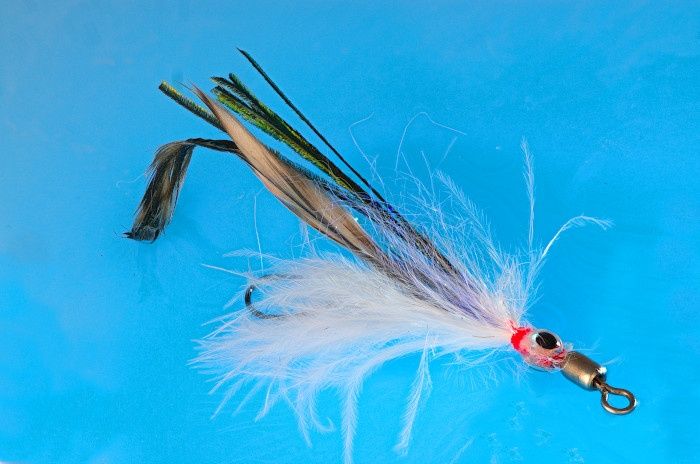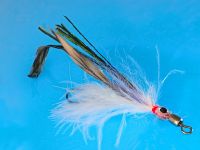Snell a hook with backing. Put a needle in the vise horizontally. Skewer the needle into the back end of the swivel. Snag a rubber band into the bend of the hook. Snag the other end of the rubber band around the back end of the vise.
Now you can tie feathers and fuzz around the rear-facing loop of the swivel, and then press on some sticky backed eyes. Then dribble ZapAGap (relatively thick CA glue) onto the eyes. Put it aside for a few minutes.
That's how to make a snellie. This one also has the curly-que tail, so it's more than just a snellie. It's a Twister Sister tail. I make the curly saddle hackle tail by molding it around a hot glue stick with plumber's silicone seal. It's important to mold only the tip end of the saddle hackle feather, else the fly becomes too wind resistant to cast. The tail flaps and flutters as you strip the fly. If you want extra weight you can put large tungsten beads on the leader, like a slip sinker on a Carolina Worm rig.
This fly sure does move in the water. Without the swivel up front the leader would twist too much to use. With the swivel it works, and the fly swims all over the place. And flutters.
Good streamer. They sure did bang it last Tuesday, in November, here in Montana, USA.
Note: If the back loop of the swivel doesn't give you enough space to tie on all the adornments you want you can wrap the rear wire loop of the swivel plus the front 1/2" inch or so of the snell will spawn sack netting. Soak that with Aleene's Flexible Stretchable fabric cement. Now you have longer foundation to tie on-------that is still soft and flexible. Any streamer ever made can be tied as a snellie.
Among other things it's a good way to put a reasonably-sized hook halfway back on a long streamer in order to prevent short-striking--without using a ridiculously long shank hook.





